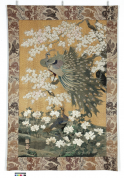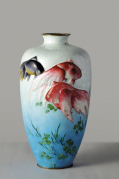Media
Exquisite Craftsmanship :
Exhibition of the Japanese Cloisonné Enamels and Embroideries of the Meiji Period from the Collections of the Ise Foundation
05 Jul 2013
Officiating guests: (from left) Mr Tetsuya Ishii, Deputy Consul-General of Consulate-General of Japan in Hong Kong, Mr Hikonobu Ise, Chairman of the Board of Trustees, Ise Foundation and Dr Florian Knothe, Director, University Museum and Art Gallery
The University Museum and Art Gallery held the opening ceremony of the exhibition of the Japanese Cloisonné Enamels and Embroideries of the Meiji Period today (July 5) and will showcase56 cloisonné enamels and 16 embroidered textiles from the collections of the Ise Foundation in Tokyo Japan, starting from tomorrow (July 6) to September 1, 2013. These treasures are executed in sophisticated techniques and exemplary of the high skill and exquisite craftsmanship for which the Meiji Period (1868–1912) is celebrated.
During the second half of the nineteenth century, following Japan’s opening to the West during the Bakumatsu period (1853–1867) at the eve of the Edo reign, the country transformed itself from an isolated feudal nation to a world power. In this rapid social development and modernization of its industries, Japan’s traditional arts were neither suppressed nor extinguished but, after the young Emperor Meiji (1852–1912) assumed the throne in 1867, Japan’s new leadership realised that the historic skills of the metalworker, lacquerer, enameller and ceramic and textile artist could assume an important role in an open and more accessible international consumer market.
In subsequent years, enamelled objects (shippo) were made on the orders of the Imperial Household—they often show the kikumon or chrysanthemum symbol indicating that they were commissioned by the Emperor as gifts for foreign dignitaries and royalty— or for merchants who supplied local and overseas markets. Japanese manufacturers participated in regularly organized international expositions and World Fairs in Europe and America, where they displayed an array of artistic creativity and technical virtuosity. The Nagoya Cloisonné Company even won a first prize at the Vienna Exhibition of 1873. Among the most important technical advance in Japanese enamel making was the development of the Yusen-shippo by Tsunekichi Kaji (1803–1883) in 1833, who glued thin filigree wires of brass, gold or silver onto the base metal, which became both an integral part of the design, and prevented the enamels from running during firing. In 1868 Tsukamoto Kaisuke (1828–1887) fired Jitai-shippo, a ceramic pottery he decorated with filigree wires and fired enamels. A decade later, Namikawa Sōsuke (1847–1910) created Musen-shippo in 1879, an enamel ware without wires that allowed the artist to compose landscape designs with more fluid outlines.
Like the shippo wares, Japanese embroidered textiles were first produced during the Nara period (710-794) and became known for their technical innovation. They testify to artistic exchanges between Japan and the West in the late nineteenth- and early twentieth-centuries. An evolution of original dyeing technology from the Nara to the Edo period (1615–1868), led to the development of so-called “embroidery pictures” that stand out by their usage of glossy silk thread, which allowed Japanese needle workers to compose new expressions superseding though historically related to conventional paintings with thread. Ribbed silk (shioze) and metallic threads on silk brocades are but few of the precious techniques and materials that make this handicraft a modern and internationally appreciated art form that uses and re-interprets an abundance of traditional iconographic compositions, symbols and figures.
The Ise Foundation offers the opportunity to share their masterpieces with the public and to show together for the first time two very different but equally sophisticated and innovative art forms. May the dazzling colours and opulent lustre provide evidence for the world-wide changes in social and domestic life towards the end of the nineteenth century and the longing for luxury that characterises the bourgeois society of that era.
The exhibition preview will take place at the Museum at 6:00 pm on Friday 5th July, 2013. Members of the press are warmly invited to attend.
Details of the Exhibition :
Date: July 6 to September 1, 2013
Venue: University Museum and Art Gallery, HKU
Please visit www.hkumag.hku.hk or http://www.cpao.hku.hk/media/meiji.pdf or call 2241-5500
Opening hours of the Museum :
Monday to Saturday 9:30 am to 6:00 pm
Sunday 1:00 pm to 6:00 pm
Closed on public holiday
Admission is free. All are welcome.
For media enquiries, please contact Communications and Public Affairs Office:
Assistant Director (Media) Ms Trinni Choy, tel: 2859 2606 email: pychoy@hku.hk , or
Manager (Media) Ms Rhea Leung, tel: 2857 8555 / 9022 7446 email: rhea.leung@hku.hk


